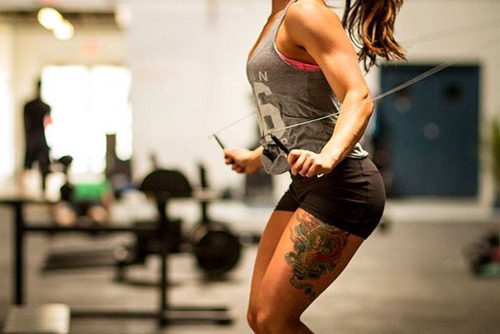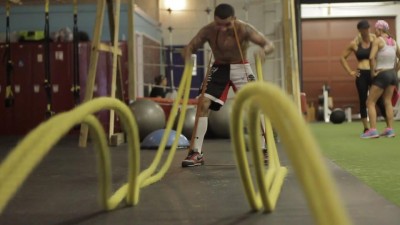Jumping rope, we have all done it, even if it was just in gym class as kids. It’s a simple enough exercise, really, swing the rope over your body and jump when the rope gets to your feet. It’s an old-school exercise.
I am sure back in the day there were even a couple of cavemen having jump rope contests using a vine for a rope and whoever could jump it the most times without stopping got the bigger turkey leg.
It’s a great exercise, but is as time passes and people aren’t in elementary school gym class anymore, they seem to give up on the jump rope as they move on with life. Even if they are still athletes, most sports don’t even use jumping rope as part of their training aside from boxing, MMA and wrestling.
Even sports like football and soccer that require foot skills and quickness somehow don’t utilize the jump rope as part of their training. It makes me sad to see all those poor under-used jump ropes laying in the corner all alone just waiting for someone to swing them around, so today I am going to make a case for why you should probably dust off that old jump rope and put it to some good use.
Benefits of Jumping Rope
Look, jumping rope might not have the cool factor of deadlifts or sprints, but don’t sleep on its benefits. Whether you’re using it as a warm-up or integrating it into your workout, it’s a game-changer. Here’s why:
First off, let’s talk athleticism. Jumping rope is basically a masterclass in balance and coordination, the unsung heroes of being athletic. You can’t jump rope without nailing those two down, trust me.
Now, onto ankle and foot stability. Ever rolled an ankle? It’s not fun. Jumping rope strengthens those smaller muscles and tendons around the ankle, making you less injury-prone.
Cardio, anyone? You might have fond memories of skipping rope as a kid, but try doing it for 10 minutes straight now. If you’re not in shape, you might not even last five. It’s tougher than it looks, making it an excellent cardio workout.
Speaking of workouts, let’s talk calories. Jumping rope can torch over 10 calories a minute. So, if you’re looking for bang for your buck in a workout, this should be on your list.
You’ll also sharpen your coordination with this exercise. If you find yourself tripping over the rope more often than not, don’t sweat it. Keep at it, and you’ll see your coordination go through the roof.
Worried about your knees? Jumping rope is actually pretty low-impact, considering you’re only hopping an inch or two off the ground. Easy on the joints, but hard on the calories.
Portability is another big win. You can stash a rope in your backpack, gym bag, or even your purse and turn any spot into your personal gym.
Oh, and for those muscleheads who can’t seem to move with any sort of grace? A jump rope could add a dash of finesse to their routine. No one ever said being jacked and agile were mutually exclusive, after all.
Athletes and Rope Jumping
Rope jumping as far as athletes are concerned, seems to have become more of an old-school exercise. Many athletes, coaches and trainers alike seem to have moved on from the old jump rope.
That is except for boxing, wrestling and MMA. These sports still make some pretty good use of the jump rope. In training for other sports, it is mostly nonexistent, aside from some coaches and trainers here and there.
While wrestlers and MMA fighters use it mainly as a conditioning tool it’s the boxers that really put in a lot of hard work with the jump rope. For boxers, rope jumping is one of their workout staples used to improve footwork, improve endurance and timing. They also use it to improve awareness while in motion, if you don’t have at least some level of focus while jumping rope you will be getting tripped up on the rope pretty regularly. In a boxing match if you lack focus you will get your head beat in. It also helps boxers be light on their feet so they can float like a butterfly and sting like a bee.
CrossFit and the Rebirth of Rope Jumping
I know some of you are rolling your eyes at even the thought of CrossFit, but CrossFit has brought back the jump rope in many regards. If you don’t believe me just ask a jump rope Manufacturer. Heck, there is a whole jump rope industry now with the CrossFitters and their speed ropes.
CrossFit doesn’t just do the standard jump roping though, CrossFit athletes do what is called the double under. When you do double-unders the rope goes around twice per jump, you need to swing the rope faster and jump a little higher to make it work. It requires a certain amount of timing and endurance to keep that going and you should also use one of those speed ropes for this to make it a little easier on yourself. Word of warning: learning how to do double unders can be a bit on the painful side.
Advanced Rope Jumping
The double under is tough without a doubt but it’s not the Mount Everest of rope jumping so to speak. Many CrossfFtters, boxers and other athletes can do triple and even quadruple unders. These are some next-level skills for when you have mastered the double under and are looking for a challenge. There are even a select few out there that can do quintuple unders, hardly anyone can do these for reps though.
More Advanced Techniques
Once you have mastered the double, triple, and maybe even the quadruple jump, there are even more advanced techniques out there. There is also crisscrossing, which you saw in the Floyd Mayweather Jr. video above. Crisscrossing really isn’t too hard once you get good at rope jumping. Try mixing it in with some double-unders and rope skipping outside of your body area, and you can really start impressing people then.
Or you could just take it to a whole new level like World Champion Adrienn Banhegyi and former Olympic wrestler Buddy Lee. These two are pretty much the cream of the rope jumping crop and have worked for years on their craft. Just a word of warning they will likely make you feel very inadequate as a rope jumper.
There you have it. Get out there and grab a jump rope and increase your athleticism, your finesse and your endurance.

Ryan is a former college wrestler and lifelong fitness fanatic with over 25 years in the industry. He’s run half marathons, tackled mud runs, placed in body transformation contests, and coached everything from wrestling to girls’ soccer.
Along the way, he’s tested hundreds of supplements and built a deep well of supplement knowledge. His work has appeared in Muscle & Strength, Testosterone Junkie, The Sport Review, and more. Today, he’s the editor-in-chief of this site, still training hard and helping others reach their goals. Connect with him on LinkedIn below.










